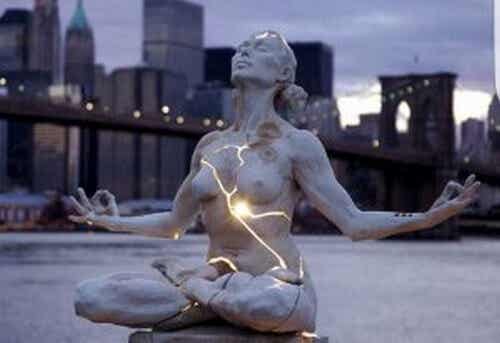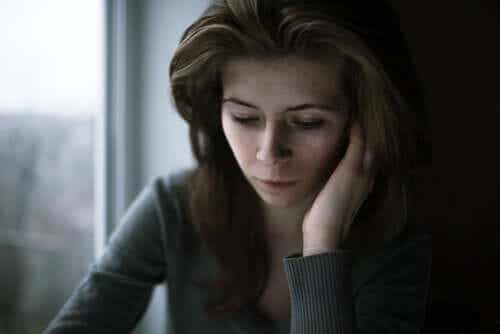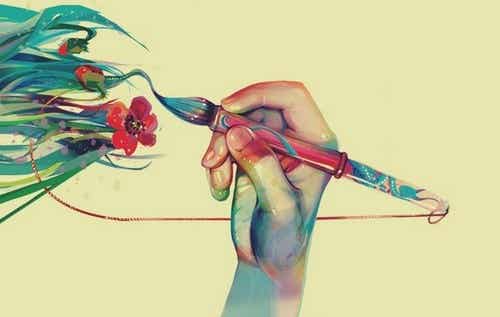
Last update: 24 March, 2022
Observing Van Gogh's Starry Night, waking up early to see the sunrise, reveling in Milan Kundera's The Unbearable Lightness of Being or closing your eyes to listen to Debussy's Moonlight are incredible experiences that awaken a hurricane of emotions. The beauty released by art and by some everyday phenomena is so immense that it is impossible not to surrender to it. Today we talk about aesthetic emotions.
This experience so profound that it takes hold of us when we observe a work of art, a landscape or an attractive face, sees emotions as responsible. If we think about it, one of the main objectives ofart is precisely to arouse emotions, communicate them, share them or provoke them in the observer. To this we owe such a deep connection. These are not just any emotions, but aesthetic emotions.
"The judgment of taste consists precisely in calling something beautiful only because of its property of agreeing with our way of perceiving it."
- Immanuel Kant-
Aesthetic emotions
According to Rafael Bisquerra, lecturer at the University of Barcelona, aesthetic emotions are the emotional response to beauty, to any kind of beauty, which can be understood as a work of art, a landscape or a person. Anything capable of making an emotional impact.
"Beauty perishes in life, but it is immortal in art".
-Leonardo da Vinci-
Although emotional emotions are manifested in the presence of certain artistic manifestations, it is a phenomenon that transcends art, in other words, goes further. It is the emotional experience in the face of beauty, the one that arises from sensitivity, the result of the connection of what we are observing or, in some cases, listening to and which produces a very pleasant, almost indescribable sensation.
Aesthetic emotions do not only concern the side of pleasure, pleasantness and positive; unpleasant and negative feelings are also part of it. For example, looking at Goya's painting On May 3, 1808, we can feel anger, anger, anxiety, depending on the meaning we give it and our experience. Just as observing Antonio Canova's Amor and Psyche sculpture, we can feel nostalgia, love and tenderness. It all depends on our gaze.
The important thing is the magic that comes from the connection with beauty, the personal experience of emotional impact. For this reason the concept of aesthetic emotions is so ambiguous, because each of us experiences them starting from different stimuli. Furthermore, it is a practically unknown phenomenon, with supporters and opponents. Some of the authors who have talked about it are Dickie (1974), Lazarus (1991), Hjorth and Laver (1997) and Levinson (1997).
The mystery and difficulty of aesthetic emotions lies in the ability to understand how and under what conditions they can be generated through artistic, sporting, scientific events, etc. The educational field is therefore considered one of the best contexts to get in touch with.
“Looking at something is very different from seeing it. You don't see a thing until you see its beauty. "
-Oscar Wilde-
Aesthetic emotions and education
Always according to Rafael Bisquerra, a goal of education should be to savor aesthetic emotions. To make students aware of this type of emotion, not only on a theoretical level, but also on a practical level, by introducing situations that favor emotional experiences of an aesthetic nature. In other words, learn to get excited and enjoy it.
“It is difficult to evaluate beauty, and I am not prepared for it. Beauty is an enigma. "
-Fëdor Michajlovič Dostoevskij-
This methodology facilitates contact with the emotional world for pupils and, in some way, it also affects aspects such as awareness and emotional regulation. Contemplating a work of art can awaken different feelings and emotions depending on the context and personal history of the pupil, and the pupil will have to learn to manage them.
Subjects such as music, natural sciences or art history will become the main vehicle for this kind of emotion, which in turn will stimulate learning. This implies integrating theemotional education.
Works to experience aesthetic emotions
Before we finish, we would like to leave you a selection of works of art with which to experience aesthetic emotions. Maybe you will try them or maybe not, it depends on each of you ...
Starry Night Over the Rhone by Vincent Van Gogh
Sonnet 126 by Lope de Vega
"Abandon yourself, dare, be furious,
tender, harsh, liberal, shy,
soulful, broken, dead, alive,
loyal, treacherous, cowardly and courageous;
find no rest and ease except good,
to be shown to another, gentle, wild, joyous,
angry, pusillanimous, aggressive,
satisfied, adontato, suspicious;
turn away from clear disillusionment,
drink poison for grateful liquor,
forget about profit, love damage;
believe that a heaven has entered a hell,
to give soul and life to a disillusionment:
this is love: whoever has tried it knows it. "
For Beethoven's Elisa
Cenotes in Yucatan (Mexico)
Ocean Atlas di Jason deCaires Taylor
Wish you were here dei Pink Floyd
Love by Alexander Milov
As a cover image we have Paige Bradley's Expansion sculpture


























